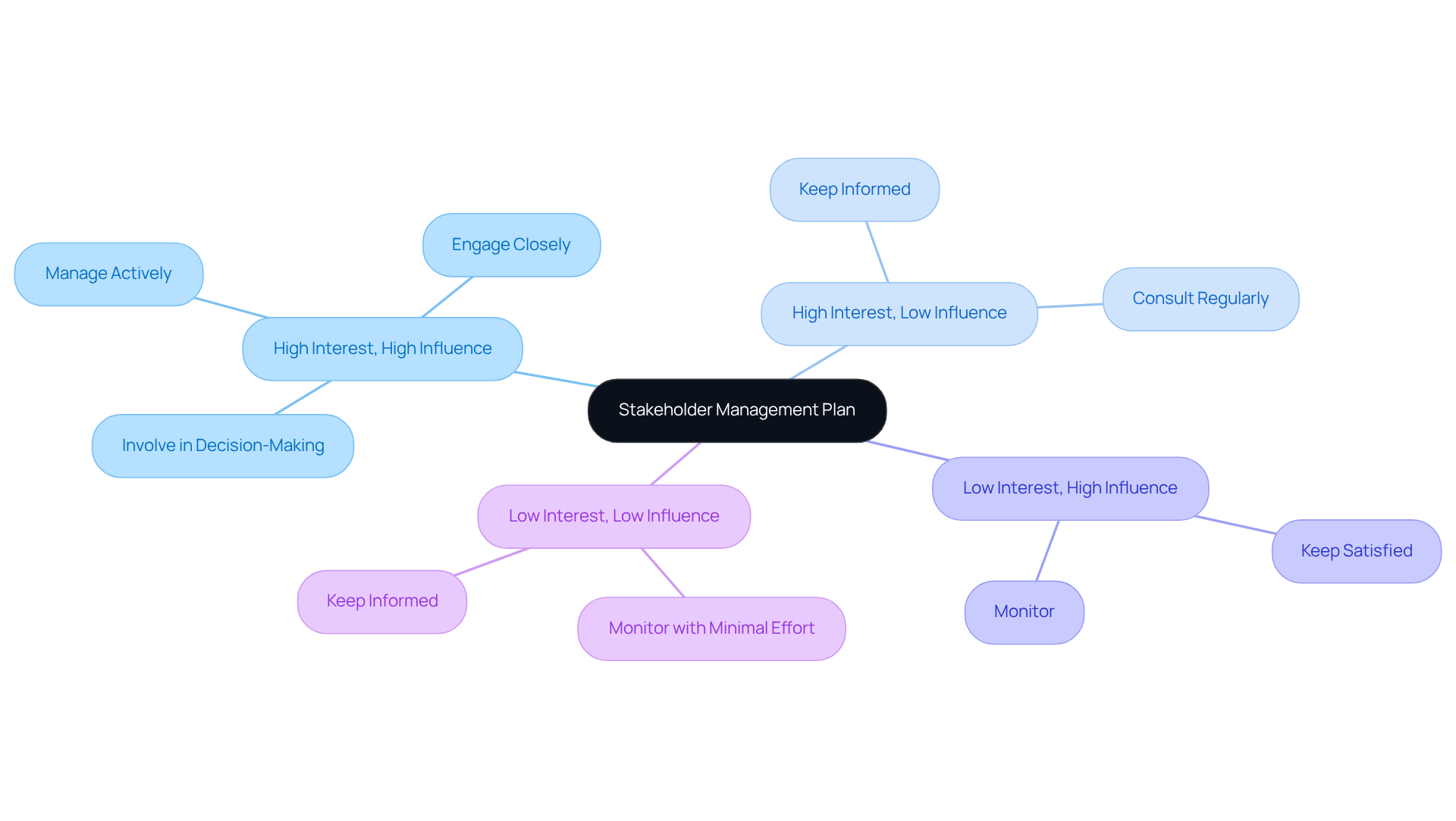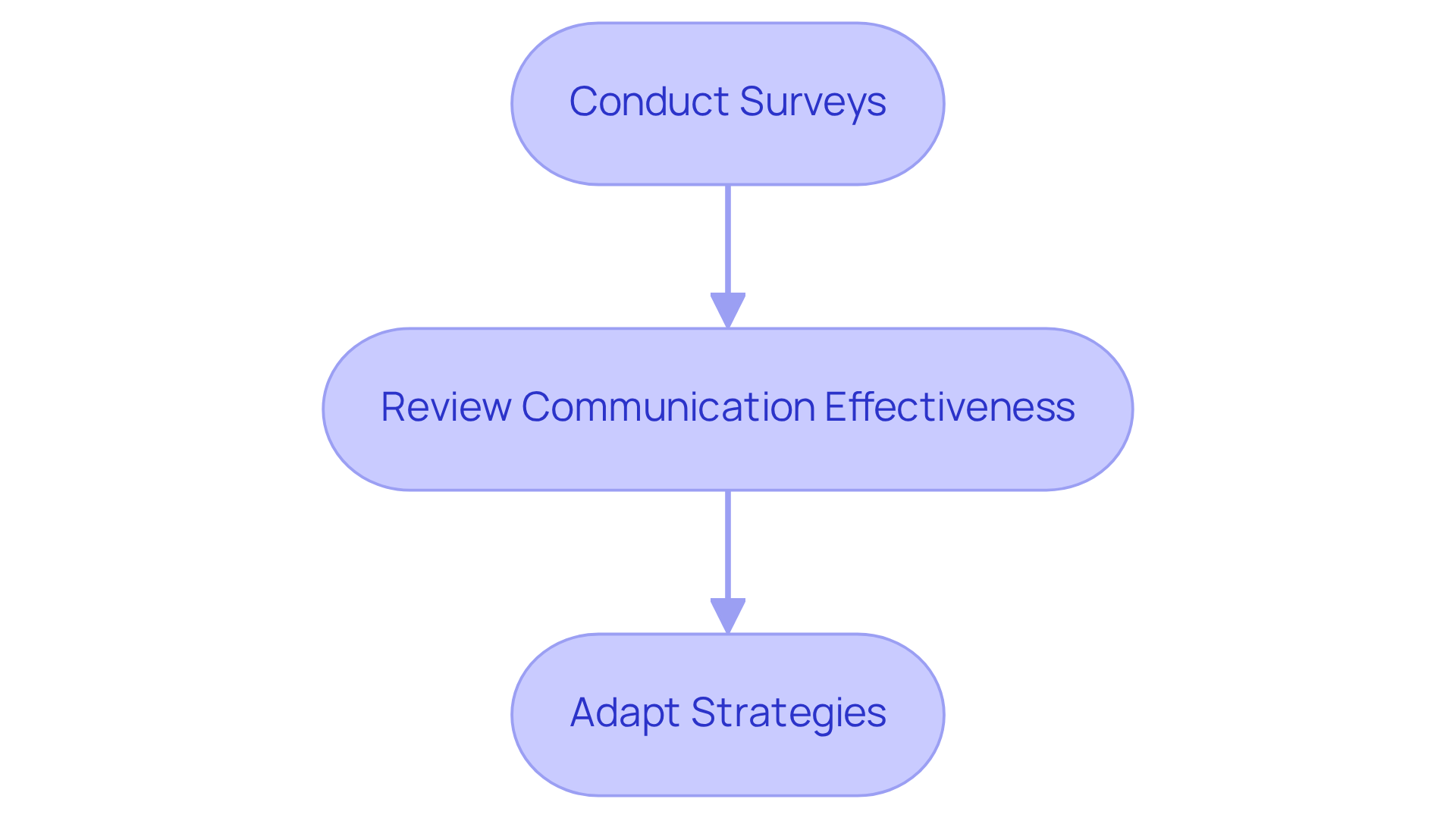Overview
Creating a stakeholder management plan is essential for financial success. It involves systematically identifying, analyzing, and engaging stakeholders to align their interests with organizational goals. Effective stakeholder engagement significantly enhances project success rates and mitigates risks. Statistics reveal that organizations with strong stakeholder involvement experience higher project effectiveness and financial performance. Consequently, prioritizing stakeholder management is not just beneficial; it is imperative for achieving organizational objectives.
Introduction
Crafting a robust stakeholder management plan is essential for organizations aiming to navigate the complexities of modern business landscapes. By effectively engaging various stakeholders—from employees to investors—companies can enhance their financial performance and mitigate risks.
However, the challenge lies in understanding the intricate dynamics of these relationships: how can organizations ensure that each party remains informed, valued, and aligned with overarching goals?
This article delves into the strategic steps necessary for creating a stakeholder management plan that not only fosters collaboration but also drives financial success.
Define Stakeholder Management
Engaging interested parties necessitates a systematic approach that outlines how to create a stakeholder management plan, involving identification, analysis, planning, and execution of effective strategies. Stakeholders include a diverse array of individuals and groups—employees, customers, suppliers, investors, and regulatory bodies. A robust participant coordination strategy is essential to ensure all parties remain informed, engaged, and aligned with the organization's objectives, directly contributing to financial success.
Effective management of relationships with interested parties is crucial for understanding how to create a stakeholder management plan to mitigate risks and seize opportunities, particularly in times of financial crisis. By leveraging real-time analytics through our client dashboard, organizations can continuously monitor participant involvement and business performance, facilitating rapid decision-making that sustains business health.
Statistics reveal that organizations with strong participant engagement witness a 15% increase in project success rates, while those boasting over 80% active sponsors enjoy 40% more effective projects. Furthermore, 62% of successfully completed projects had supportive sponsors, contrasting with the 33% of projects that fail due to inadequate senior management involvement, underscoring the vital role of interested parties in achieving desired outcomes.
Establishing clear, measurable KPIs for tracking participant involvement is imperative for understanding how to create a stakeholder management plan that refines engagement strategies and enhances overall project results. By applying insights gained from past experiences, organizations can forge strong, lasting connections with interested parties, further driving financial success.
Identify Your Stakeholders
Recognizing stakeholders represents a crucial initial phase in understanding how to create a stakeholder management plan. Start by compiling a comprehensive list of individuals and groups as part of how to create a stakeholder management plan for your organization. Consider categorizing them into the following groups:
- Internal Stakeholders: This group encompasses employees, management, and board members who directly influence or are impacted by organizational decisions.
- External Stakeholders: This includes customers, suppliers, investors, community members, and regulatory agencies that interact with your organization and can impact its success.
Once you have compiled this list, prioritize participants based on their influence and interest in understanding how to create a stakeholder management plan for your organization. This prioritization is essential, as it enables you to focus your efforts on those parties who are most critical to your financial success. Current trends indicate that proactive participant identification can significantly reduce risks during strategy implementation, particularly in crisis management scenarios. By understanding the dynamics of relationships with involved parties, CFOs can align organizational strategies with their needs, ultimately enhancing the potential for sustainable growth.
Analyze Stakeholders' Interests and Influence
Recognizing the parties involved is just the beginning; it is essential to assess their interests and influence, which is part of how to create a stakeholder management plan using a matrix. This matrix categorizes stakeholders into four distinct groups based on their level of interest and influence:
- High Interest, High Influence: Engage closely and manage actively. These parties are essential to project success and should be involved in decision-making processes to ensure their needs are met.
- High Interest, Low Influence: Keep informed and consult regularly. While they may not wield significant power, their support can be vital for project momentum.
- Low Interest, High Influence: Keep satisfied and monitor. These parties can considerably influence project results, so ensuring their contentment is crucial, even if they are not actively engaged.
- Low Interest, Low Influence: Monitor with minimal effort. These parties require less attention but should still be kept informed to avoid any potential issues.
Understanding how to create a stakeholder management plan helps in identifying where each participant falls within this matrix, enabling customized communication and engagement strategies. For instance, high-interest, high-influence participants should receive regular updates and opportunities for input, while low-interest, low-influence individuals can be engaged through periodic communications. This strategic approach not only addresses their concerns but also secures their support, ultimately improving project outcomes.
Moreover, incorporating streamlined decision-making processes and real-time analytics can further enhance participant involvement. By employing the interest holder matrix, organizations can understand how to create a stakeholder management plan that prioritizes their involvement efforts, ensuring that resources are allocated efficiently to maximize contributions from interested parties and drive financial success. Statistics show that projects with robust participant engagement strategies succeed 83% of the time, emphasizing the essential role of effective management of these connections. Furthermore, the incorporation of real-time analytics via a client dashboard facilitates ongoing observation of business performance, allowing for prompt modifications to strategies and improving participant engagement.

Develop a Stakeholder Communication Plan
To develop a stakeholder communication plan, follow these essential steps:
- Define Objectives: Clearly determine what you aim to achieve with your communication efforts.
- Choose Communication Channels: Select the most suitable channels for each group of interested parties, such as emails, meetings, or newsletters.
- Set Frequency: Decide how often you will communicate with each interest group to ensure consistent engagement.
- Craft Key Messages: Develop clear and concise messages tailored to the interests and concerns of each party.
- Assign Responsibilities: Designate specific team members responsible for communicating with particular parties.
By implementing a structured communication plan, you ensure that interested parties are kept informed and engaged, which is critical for navigating financial challenges. For additional details on enhancing your engagement strategies, feel free to contact us at Transform Your Small/ Medium Business at +1 (239) 428-9074 or visit us at 3200 Bailey Ln, Naples, FL 34105 for the latest updates and insights.
Monitor and Adapt Your Stakeholder Management Plan
To ensure the effectiveness of your management plan, it is essential to understand how to create a stakeholder management plan by regularly monitoring its implementation and gathering feedback from involved parties. Consider the following actions:
- Conduct Surveys: Utilize surveys or feedback forms to assess stakeholder satisfaction and identify any concerns. Research indicates that companies interacting with interested parties are 30% more likely to succeed with new products, underscoring the importance of this input.
- Review Communication Effectiveness: Evaluate whether your communication strategies are achieving their objectives. Successful involvement of interested parties can significantly enhance relationships, boosting sales and loyalty.
- Adapt Strategies: Be prepared to modify your engagement strategies based on feedback and evolving circumstances. For instance, during emergencies, adjusting participant engagement strategies can lead to better outcomes and minimized risks.
By continuously monitoring and refining how to create a stakeholder management plan, you can strengthen relationships and enhance your organization's capacity to successfully navigate financial challenges. Regularly collecting and analyzing stakeholder satisfaction data is vital, as it not only improves business models but also fosters stakeholder loyalty, which is crucial for long-term success.

Conclusion
Creating a comprehensive stakeholder management plan is pivotal for organizations seeking to thrive in today's complex business environment. By systematically engaging stakeholders—from internal teams to external partners—companies can not only enhance their financial performance but also build resilient relationships that weather challenges.
The article outlines essential steps for developing an effective stakeholder management plan, including:
- Identifying stakeholders
- Analyzing their interests and influence
- Creating a tailored communication strategy
- Continuously monitoring and adapting the plan
Each of these components plays a crucial role in fostering engagement, ensuring that all parties feel valued and aligned with the organization's objectives.
Ultimately, the significance of stakeholder management extends beyond mere project success; it is a foundational element for sustainable growth and financial stability. Organizations are encouraged to embrace these best practices, leveraging insights and feedback to refine their approaches. By prioritizing stakeholder engagement, companies can unlock new opportunities, mitigate risks, and pave the way for long-term success.
Frequently Asked Questions
What is stakeholder management?
Stakeholder management is a systematic approach to creating a stakeholder management plan that involves identifying, analyzing, planning, and executing effective strategies to engage various interested parties, such as employees, customers, suppliers, investors, and regulatory bodies.
Why is effective stakeholder management important?
Effective stakeholder management is crucial for understanding how to create a stakeholder management plan that mitigates risks and seizes opportunities, especially during financial crises. It helps ensure that all parties remain informed, engaged, and aligned with the organization's objectives, contributing to financial success.
What are the benefits of strong stakeholder engagement?
Organizations with strong stakeholder engagement experience a 15% increase in project success rates. Additionally, those with over 80% active sponsors see 40% more effective projects, and 62% of successfully completed projects had supportive sponsors.
How can organizations track stakeholder involvement?
Establishing clear, measurable KPIs for tracking stakeholder involvement is essential. This helps organizations refine engagement strategies and enhance overall project results by applying insights gained from past experiences.
How should stakeholders be identified?
Stakeholders should be identified by compiling a comprehensive list of individuals and groups, categorizing them into internal stakeholders (employees, management, board members) and external stakeholders (customers, suppliers, investors, community members, regulatory agencies).
Why is prioritizing stakeholders important?
Prioritizing stakeholders based on their influence and interest is essential as it enables organizations to focus their efforts on those parties most critical to financial success, thereby reducing risks during strategy implementation, particularly in crisis management scenarios.
How can stakeholder management contribute to sustainable growth?
By understanding the dynamics of relationships with stakeholders, CFOs can align organizational strategies with their needs, enhancing the potential for sustainable growth.




